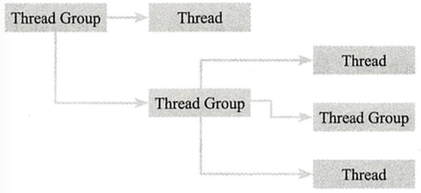ThreadGroup是Java提供的一种对线程进行分组管理的手段,可以对所有线程以组为单位进行操作,如设置优先级、守护线程等。
线程组也有父子的概念,如下图:
![]()
线程组的创建
1 public class ThreadGroupCreator {
2
3 public static void main(String[] args) {
4 //获取当前线程的group
5 ThreadGroup currentGroup = Thread.currentThread().getThreadGroup();
6 //在当前线程执行流中新建一个Group1
7 ThreadGroup group1 = new ThreadGroup("Group1");
8 //Group1的父线程,就是main线程所在Group
9 System.out.println(group1.getParent() == currentGroup);
10 //定义Group2, 指定group1为其父线程
11 ThreadGroup group2 = new ThreadGroup(group1, "Group2");
12 System.out.println(group2.getParent() == group1);
13 }
14 }
线程组的基本操作
注意:后添加进线程组的线程,其优先级不能大于线程组的优先级
1 public class ThreadGroupBasic {
2
3 public static void main(String[] args) throws InterruptedException {
4
5 ThreadGroup group = new ThreadGroup("group1");
6 Thread thread = new Thread(group, () -> {
7 while(true) {
8 try {
9 TimeUnit.SECONDS.sleep(1);
10 } catch (InterruptedException e) {
11 e.printStackTrace();
12 }
13 }
14 }, "thread");
15 thread.setDaemon(true);
16 thread.start();
17
18 TimeUnit.MILLISECONDS.sleep(1);
19
20 ThreadGroup mainGroup = Thread.currentThread().getThreadGroup();
21 //递归获取mainGroup中活跃线程的估计值
22 System.out.println("activeCount = " + mainGroup.activeCount());
23 //递归获mainGroup中的活跃子group
24 System.out.println("activeGroupCount = " + mainGroup.activeGroupCount());
25 //获取group的优先级, 默认为10
26 System.out.println("getMaxPriority = " + mainGroup.getMaxPriority());
27 //获取group的名字
28 System.out.println("getName = " + mainGroup.getName());
29 //获取group的父group, 如不存在则返回null
30 System.out.println("getParent = " + mainGroup.getParent());
31 //活跃线程信息全部输出到控制台
32 mainGroup.list();
33 System.out.println("----------------------------");
34 //判断当前group是不是给定group的父线程, 如果两者一样,也会返回true
35 System.out.println("parentOf = " + mainGroup.parentOf(group));
36 System.out.println("parentOf = " + mainGroup.parentOf(mainGroup));
37
38 }
39
40 }
线程组的Interrupt
1 ublic class ThreadGroupInterrupt {
2
3 public static void main(String[] args) throws InterruptedException {
4 ThreadGroup group = new ThreadGroup("TestGroup");
5 new Thread(group, () -> {
6 while(true) {
7 try {
8 TimeUnit.MILLISECONDS.sleep(2);
9 } catch (InterruptedException e) {
10 //received interrupt signal and clear quickly
11 System.out.println(Thread.currentThread().isInterrupted());
12 break;
13 }
14 }
15 System.out.println("t1 will exit");
16 }, "t1").start();
17 new Thread(group, () -> {
18 while(true) {
19 try {
20 TimeUnit.MILLISECONDS.sleep(2);
21 } catch (InterruptedException e) {
22 //received interrupt signal and clear quickly
23 System.out.println(Thread.currentThread().isInterrupted());
24 break;
25 }
26 }
27 System.out.println("t2 will exit");
28 }, "t2").start();
29 //make sure all threads start
30 TimeUnit.MILLISECONDS.sleep(2);
31
32 group.interrupt();
33 }
34
35 }
线程组的destroy
1 public class ThreadGroupDestroy {
2
3 public static void main(String[] args) {
4 ThreadGroup group = new ThreadGroup("TestGroup");
5 ThreadGroup mainGroup = Thread.currentThread().getThreadGroup();
6 //before destroy
7 System.out.println("group.isDestroyed=" + group.isDestroyed());
8 mainGroup.list();
9
10 group.destroy();
11 //after destroy
12 System.out.println("group.isDestroyed=" + group.isDestroyed());
13 mainGroup.list();
14 }
15
16 }
线程组设置守护线程组
线程组设置为守护线程组,并不会影响其线程是否为守护线程,仅仅表示当它内部没有active的线程的时候,会自动destroy
1 public class ThreadGroupDaemon {
2
3 public static void main(String[] args) throws InterruptedException {
4 ThreadGroup group1 = new ThreadGroup("group1");
5 new Thread(group1, () -> {
6 try {
7 TimeUnit.SECONDS.sleep(1);
8 } catch (InterruptedException e) {
9 e.printStackTrace();
10 }
11 }, "group1-thread1").start();
12 ThreadGroup group2 = new ThreadGroup("group2");
13 new Thread(group2, () -> {
14 try {
15 TimeUnit.SECONDS.sleep(1);
16 } catch (InterruptedException e) {
17 e.printStackTrace();
18 }
19 }, "group1-thread2").start();
20 group2.setDaemon(true);
21
22 TimeUnit.SECONDS.sleep(3);
23 System.out.println(group1.isDestroyed());
24 System.out.println(group2.isDestroyed());
25 }
26 }





